- Home
- All Kinds of Palms
- Sun Lovin' Palms
Palm Trees for Full Sun
Many palm trees for full sun can withstand some drought. Most of our recommendations are also capable of enduring some very frigid temperatures. Do you have a place on your property that's very sunny? Then one of these could be the palm for you.
At Mission: Palm Trees
We help palm lovers simplify their searches and ease their concerns. Our articles are meant to inform, while having fun, easily Finding What You Want or Need. We eliminate unnecessary shoptalk & tiring research. We Discover For You!

Best Palm Trees for Full Sun
Fast Growing Palm Trees for Full Sun
Want to get a palm that gives you its all pretty quickly? Is this one of the Different Kinds of Palms you're considering? Give one of these an ideal sunny spot, and you'll enjoy it soon enough!
AUSTRALIAN CABBAGE PALM
Livistona australis is nice looking & grows fairly quickly. It does well with full sun. Plus can take temporary lows of 20oF/-6.6oC. Zone 9-11.
RIBBON FAN PALM
Livistona decipiens has stunning inflorescences emerging floppily upward from the crown. Showing nice yellow flowers.
Give it all it needs for quick sunny growth to 70'/21m. And you can grow it easily from seed! Zones 9-11, but 8b can be doable.
QUEEN PALM
Syagrus romanzoffiana gets sky-high (45-90 ft./13-27m) rather quickly. Not recommended for planting in Southern Florida, except when diligently attending to But Rot prevention. Otherwise Quite Hardy.
Besides sun, loves warmth & water. Best for Zones 9b-11. Warmest sunniest parts of 8b-9a can be tried.
Ripe fruits can be eaten. Some say they're delightedly sweet with plum & banana hints. but normally they're used for animal feed.
Medium Tall Sun-Loving Palms
BISMARK PALM
Bismarckia nobilis has bluish tinged fronds that love full sun.
Be cautious if temps go into the 20F/-6.6C+. Cold Damage can happen if they're chilled too long.
Zone best: 9-11. Tops off at 60ft/18m.
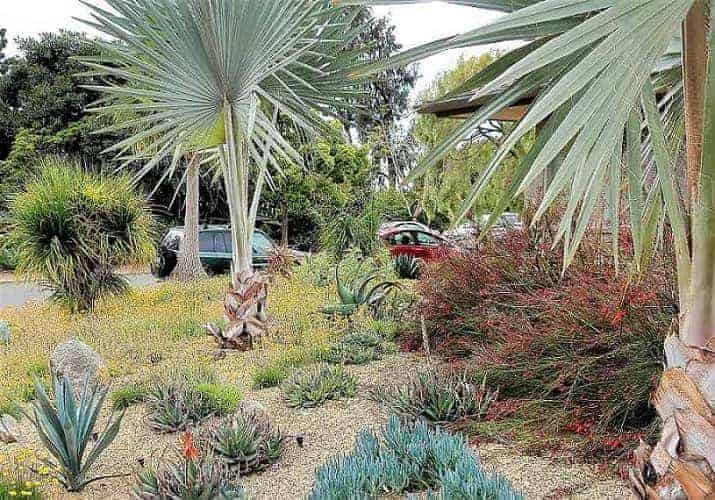 Dazzling Bismarck Palms seen when touring with the Mission Hills Garden Walk.
Dazzling Bismarck Palms seen when touring with the Mission Hills Garden Walk.Photo: KM @Flickr - CC BY 4.0
DESERT FAN PALM
Washingtonia filifera loves inland hot sun. Can even go as low as 15F/-9.4C. Native to northern Mexico, Western Arizona & low deserts in So-Cal. Zone 8-11 in areas with humidity, 7 in dry climates.
We're well familiar with the (also called) California Fan Palm, where we live in Tucson Arizona. Not so tall as the W.robusta.
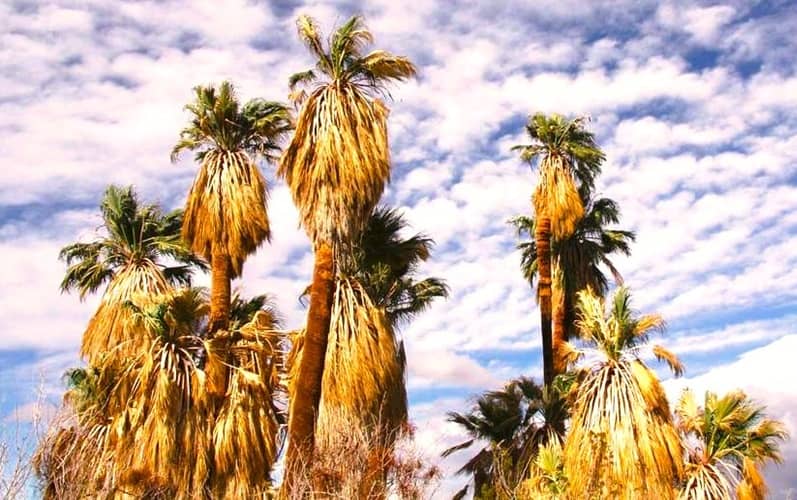 Grove of filifera palms, called tCotton Palm in the UK. Lots of petticoats!
Grove of filifera palms, called tCotton Palm in the UK. Lots of petticoats!GUADALUPE PALM
Brahea edulis has a fat trunk that takes it right through those springtime desert winds.
Full sun is okay. With caution tolerates temps as low as 18oF/-7.8C in dryer places. But ideal for Zones 9-11.
 Can be easily grown from seed. Getting up to 35 ft./10.5m tall. Photo: Herve Rey - CC-BY-SA
Can be easily grown from seed. Getting up to 35 ft./10.5m tall. Photo: Herve Rey - CC-BY-SASILVER SAW PALMETTO
Acoelorrhaphe wrightii is only advised if good watering available. Long been growing in Florida's Everglades.
It's one of those palm trees for full sun that's not drought-friendly. But known to tolerate temps to lows of 20oF/-6.7C, if temporary. Grows to 40'/12m, while clustering. Best Zones: 9b-11.
SINALOA HESPER PALM
With Brahea aculeata, full sun is a must.
It can temporarily do temps down to about 20oF/-6.6oC. Slow-growing for Zones 9-11. Dry parts of 8b possible with care.
 Sinaloa Hesper growing nicely at Fairchild Tropical Botanic Garden in Miami
Sinaloa Hesper growing nicely at Fairchild Tropical Botanic Garden in MiamiPhoto: David J Stang - CC BY-SA 4.0
Sitting Tall in the Sun!
CANARY ISLAND DATE PALM
Yes, Phoenix canariensis is native to the Canary Islands.
Majestic, slow-growing, specimen. Among The Tallest Palms.
Loves the sun, but still limitedly can go to 15oF/-9.4oC. Zone 9-11, even 8b in dry climes.
 We see plenty in our Sonoran Desert town. Beauties with a full round crown.
We see plenty in our Sonoran Desert town. Beauties with a full round crown.COHUNE PALM
Attalea cohune is impressively large & attractive.
Can get 100ft/30m tall. Its pinnate fronds, themselves, are 30'/9m long! With leaflets about 3'/90cm. Takes young Cohunes lots of time to form a solitary trunk. Then growth speeds up
Best for Zones 10-11. Can try 9b, with care.
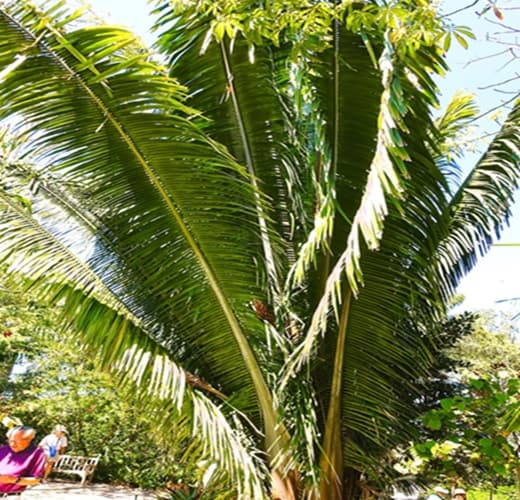 Seeing Its Youth, With Lengthy Palm Fronds
Seeing Its Youth, With Lengthy Palm FrondsAnd Here's Shorter Palms
EUROPEAN FAN PALM
Chamaerops humilis spreads out bush-like.
It sits well in full sun. And quite cold-tolerant, briefly down to 10oF/-12.2C! Brrrr!! Zones 8-11.
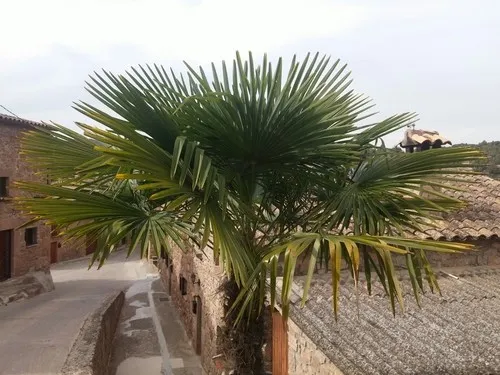 Also Known as: Mediterranean Fan Palm
Also Known as: Mediterranean Fan PalmMAZARI PALM
Nannorrhops ritcheana is small, and pretty.
A clumper with either bluish or green fronds. Loves hot deserts. Plus fleetingly tolerates a lowest temperature of 15oF. Zones 8-11, plus 7 for arid deserts.
 Showing Off its Lovely Palmate Leaves at Marie Selby Botanical Gardens, Sarasota, Florida
Showing Off its Lovely Palmate Leaves at Marie Selby Botanical Gardens, Sarasota, FloridaPYGMY DATE PALM
Phoenix roebelenii is small-sized. Wants sun & heat. Not much for cold, but short periods at 20oF/-6.7C could be okay. No lower.
 AKA Miniature Date Palm - Loving this arrangement! They Max Out at 15ft/14.5m.
AKA Miniature Date Palm - Loving this arrangement! They Max Out at 15ft/14.5m.Photo: Forest & Kim Starr - Attribution 4.0 International.
SAND PALM
Allagoptera arenaria is native to sunny seaside Brazilian regions.
But if you're inland, it'll be fine. Temps must go no lower than 28oF/-2.2C, for minimal time-frame. Zone 8b-11. Smaller size, to about 8-ft/2.4m, slowly. Fruits are edible.
Avoid planting near tall trees or buildings, if they cast shade. They don't want that!
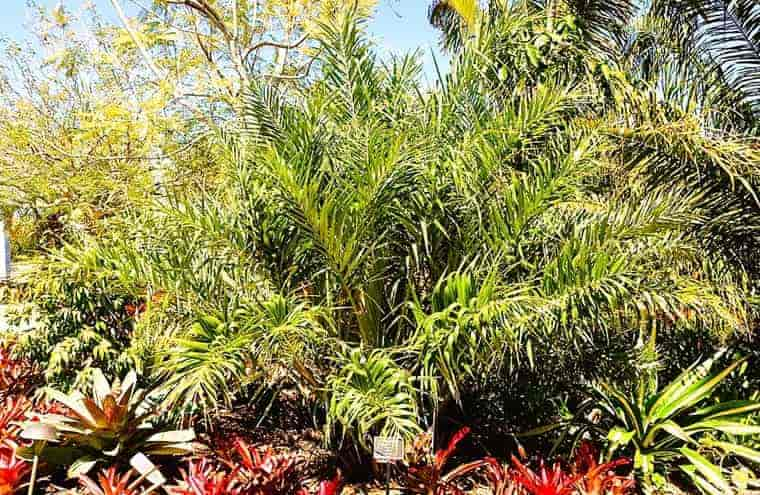 Can do some shade time. Though small, can't tolerate indoor light
Can do some shade time. Though small, can't tolerate indoor lightNot easily found to purchase! But possible. Have Patience for Up To 2 Year Wait?!
It will grow rrom seed!
Sunny Palms With Edible Fruit
DATE PALM
Phoenix dactylifera may be the most historically cultivated for fruit production. It's a true desert sun & heat lover. Still, can tolerate low temps of 18oF, for a bit. Gets pretty tall, to 90'/27m.
 Going to Sample Date Fruit With a Picnic Under the Date Palms
Going to Sample Date Fruit With a Picnic Under the Date PalmsIn Arizona's Sonoran Desert
JELLY PALM
Butia capitata, nicknamed for the Palm Fruit people turn into jellies.
It loves the desert climate. So it manages drought well. Fairly cold-tolerant, too. Handling temporary temps down to about 16oF. Zone 9-11, can do 8 for Mediterranean climates.
A shorty (35'/10.5m) that's great to consider for your Landscape Planning.
 This very hardy pinnate is also called Pindo Palm.
This very hardy pinnate is also called Pindo Palm.Photo: Herve Rey - CC-BY-SA
Stunning Sunny Lookers
MEXICAN BLUE FAN
Brahea armata is maybe the ideal inland desert palm.
Loves (Zone 8b-11) dry full sun & heat. But can also take momentary Fahrenheit plunge to about 16oF/8.8C.
Exquisite palmate leaves look like sunbursts. Stalks with creamy flowers arch upward past the fronds & then droop.
 Only gets to 30'/9m tall. Also called Blue Hesper Palm.
Only gets to 30'/9m tall. Also called Blue Hesper Palm.Photo: Berthold Werner via CCby-SA3.0
TRIANGLE PALM
Dypsis decaryi is uniquely shaped. You can't miss it!
Native to Madagascar, so it loves heat. Sun is good, too, but some recommend a bit of shade. Can go occasionally to about 26oF/-3.3C without injury. Zone 10 & 11, can try 9b with aridity.
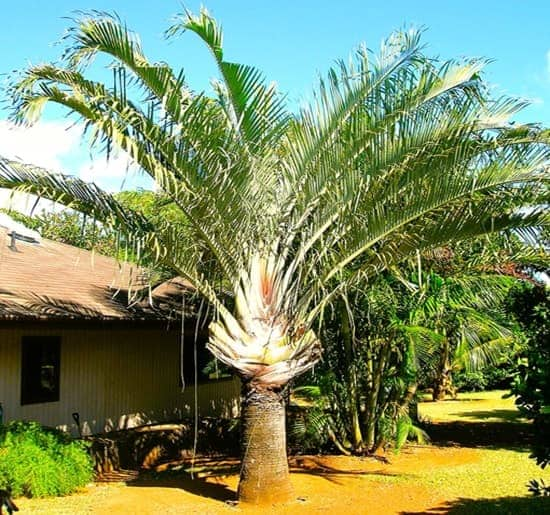 Also nicknamed Neodypsis decaryi. Gets to 40'/12m upward. Growing on a Maui property of Lilikoi Gulch Haiku
Also nicknamed Neodypsis decaryi. Gets to 40'/12m upward. Growing on a Maui property of Lilikoi Gulch HaikuPhoto: Forest & Kim Starr - CC BY 4.0
WOOLLY BUTIA PALM
Butia eriospatha is related to the Jelly.
But not as cold tolerant. Needs protection as temps go to low of 20oF/-6.6C.
Named for its woolly looking tomentum-covered (hairy matte) spathe, the woody boat-shaped Palm Part sheltering new inflorescences (flower stems).
 No trouble with hot, full desert sun!
No trouble with hot, full desert sun!Photo: Krzysztof Ziarnek - CC BY-SA 4.0
Palm Trees for Full Sun Takeaways
Many palms, if they don't love full sun, they can take it for part of the day. These palms here are true sun lovers. Many of them Are Native To deserts. Some are tropical sun-lovers.
The most important thing for growing palm trees for full sun is to be sure it's the right palm for the right place.
Latest Palm Articles/Updates
-
How Many Palms Are There? Discover Global Species
Curious about how many palms are there? We'll show you the astonishing diversity of palm species that flourish in diverse habitats. -
Beach Sunset With Palm Tree in View - Find Your Place for Bliss
Find Your beach sunset with palm tree serenity brings you that tropical calm. Evoking relaxation in just the right place for a vacation. Come on in!





